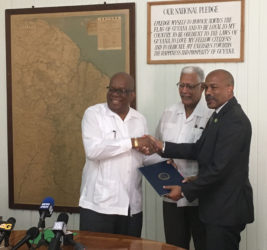In a bid to revitalize agriculture and address unemployment in several villages, which Minister of Finance Winston Jordan dubbed as “neglected”, a loan-grant agreement was signed yesterday between the Ministry of Finance and the Caribbean Development Fund (CDF) for US$10.4 million.
Four villages – Ithaca, West Coast Berbice; Triumph and Buxton, East Coast Demerara and Mocha, East Bank Demerara – have been identified as the target communities and while the CDF loan-grant agreement provides US$10.4 million, Jordan indicated that the government will contribute a further US$2 million to ensure the project is implemented fully.
“Those who live in Buxton… Mocha and Ithaca will tell you how neglected they were over the last two decades,” Jordan said. He added that he was extremely pleased at the agreement, which will ensure significant improvement in the infrastructure of those villages to benefit small-scale farmers.
More importantly, he pointed out, it will help develop the agriculture sector, which will work along with the government’s plans to deepen micro and small-scale agriculture.

CDF Chief Executive Officer Rodinald Soomer said, “This agreement delivers US$10 million of concessional assistance to Guyana for the purchase of farming equipment that will remain resident in the identified communities, to finance land clearing, to restore and upgrade drainage and irrigation canals and install a pump in the specified farming communities as well as provide technical support for targeted farmers.” He added that the project will target farmers in the four “very economically challenged areas.”
He highlighted that the areas have been selected since they have had a history of agricultural production which had become marginal over time as the entire backlands had been left uncultivated and underdeveloped due to inadequate access and poor drainage and irrigation.
“The programme is targeting areas with a combined population of 1,200 farmers, thereby potentially impacting the lives of close to 35,000 individuals,” he said, pointing out that 155 km of canals and drains will be constructed (both new and rehabilitated structures), along with 40 km of fair weather dam and one pump station.
“These interventions will enable farmers to reclaim an initial 2,500 acres of abandoned land, bringing it back into cultivation,” he said. The access to lands to cultivate will result in the increase in production which will provide for opportunities to restore agricultural exports to the Caricom market.
Soomer explained that the agreement became possible after Guyana agreed to contribute US$3,807,263 to the CDF, which allows it to access the US$10,432,263 effectively obtaining US$2.74 for every US$1 contributed.
He pointed out that the additional resources came from contributions to the CDF by other Caricom countries.
The Guyana Country Assistance Programme was approved by the 31st meeting of the CDF board on July 21, 2016, within the CDF’s thematic priority of improving existing infrastructure and promoting investment. Since it is the first intervention under the CDF’s first funding cycle it is a blend of a loan of US$6.63 million and a grant of US$3.81 million.
When asked how the country will be able to penetrate the non-tariff barriers in the other Caricom states, Jordan explained there will be a focus on value-added products. “The Caricom market is there. It is a guaranteed market,” he said.
Permanent Secretary in the Ministry of Agriculture George Jervis also explained that the project will be further developed into a programme, since it is expected to be sustainable as there will be cooperative groups working in the established communities. While the equipment will remain in the communities, they will be managed by the National Drainage and Irrigation Authority.




